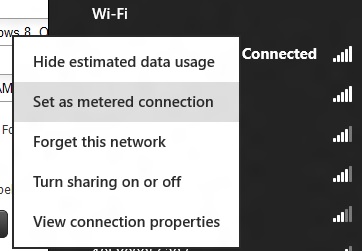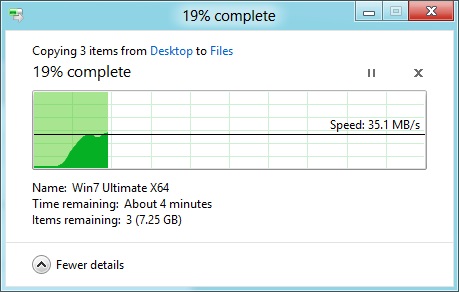In-Depth with the Windows 8 Consumer Preview
by Andrew Cunningham, Ryan Smith, Kristian Vättö & Jarred Walton on March 9, 2012 10:30 AM EST- Posted in
- Microsoft
- Operating Systems
- Windows
- Windows 8
Networking improvements
The widespread adoption of cellular connectivity in an increasing number of laptops and tablets have made our computing devices more mobile than ever before, but it has also given rise to an age of data caps, bandwidth throttling, and exorbitant prices from carriers. In the United States, unlimited data plans are a thing of the past, and as such any operating system worth its salt is going to have to be more careful about what, where, when, and how it sends and receives data.
To that end, Microsoft has instituted several features in Windows 8 that both users and developers can utilize to measure data usage and keep it in check.

Thanks to class drivers (which we'll discuss in just a minute), mobile broadband chips are treated as first-class devices in Windows 8—the same as wi-fi, ethernet, Bluetooth, and USB 3.0, among others—which means that broadband adapters can be turned on and off through the Windows GUI in the same way that wi-fi and Bluetooth now are, and there's also an Airplane Mode can turn all of it off in one swoop, just like on a smartphone (see above). As on phones, Windows will automatically prioritize wi-fi networks when both wi-fi and cellular are available.
This increased integration into Windows has many benefits: if your laptop or tablet has a SIM card installed, Windows can automatically detect which carrier it's associated with and download any available mobile broadband app from the Windows store, and carrier-unlocked laptops and tablets can choose between multiple cellular carriers if the hardware supports it. Windows also offers estimated data usage figures when connected to cellular networks, and when connected to a cellular network the OS will adjust its default behaviors to conserve bandwidth (for example, deferring the automatic downloading and installation of Windows updates until wi-fi is available).

Though it is off by default, these bandwidth conservation features can also be enabled for traditional wired and wireless network connections by right-clicking the name of the network you're connected to. While on a metered network, apps can now use new APIs to force network-aware Metro apps to use less data when possible (another example: using a low-bandwidth movie stream rather than a high bandwidth one). Network-aware Metro apps are required to use these APIs, and users can check how much bandwidth apps are using (both on metered and non-metered networks) in the new Task Manager.
Improvements to networking in Windows also extend to file copying, namely the SMB networked file sharing protocol. In Windows 8, the protocol can now shift dynamically between different network adapters during copy operations so that it always uses the fastest possible connection to transfer files. To demonstrate, I began copying a few gigabytes of data to a fileserver on my home network using a slow wireless G connection:

Then, without pausing the file copy operation or disabling my wireless card, I plugged the laptop into the network with a gigabit ethernet cable:

As you can see, as soon as Windows detected a faster network interface, it without complaint began copying the files using the faster connection. I then unplugged the laptop from the ethernet cable:

Again without issue, it switched back to the slower connection and continued copying the files. While this flexibility is impressive, it should be noted that it can only kick in for file transfers between two Windows 8 (or Windows Server 8) computers.
Drivers
Windows Vista broke a lot of things when it launched, and drivers was a big one—at least part of Vista’s caustic reputation was earned because third-party drivers made the platform so unstable. Since then, Microsoft has been committed to maintaining driver compatibility between Windows versions. During my testing, I found that the vast majority of drivers certified for Windows Vista and Windows 7 worked without issue in Windows 8, lending credence to Microsoft’s assertion that Windows 8 will be able to run on anything that could run Windows 7.
Windows 8’s main innovation is the sheer number of class drivers it introduces. For the un-indoctrinated, class drivers target defined specifications rather than specific hardware. Class drivers are the reason you don’t need to install specific software to run things like mice, keyboards, or USB 2.0 controllers.
Windows 8 adds new class drivers for things like USB 3.0 controllers, printers, motion sensors, mobile broadband cards, and a few others, all of which should be very useful on modern systems running Windows 8 or Windows on ARM. My personal experience extends to the USB 3.0 driver, which worked just fine for the oddball Fresco controller in my Intel desktop board, and the printer drivers, which worked well for a variety of local and networked printers I connected to from my various Windows 8 testbeds.
Microsoft also provides a new basic display driver in Windows 8. While the old generic display driver ran using the Aero Basic theme, the new driver appears to have basic support for Aero effects and transparencies. Among the systems that I tested, only a few had GPU-specific graphics drivers that installed from the DVD. While this may not be true of the RTM version of Windows 8, it looks like Microsoft is scaling back on the number of included graphics drivers to save space—you’d best check Windows Update or your manufacturer’s web site for updated graphics drivers, if they’re not included.










286 Comments
View All Comments
Impulses - Friday, March 9, 2012 - link
I plan to start my own riot once I'm done reading if there isn't any multi-display discussion... :pMrSpadge - Friday, March 9, 2012 - link
AMD fans can be quite thin-skinned..Kristian Vättö - Friday, March 9, 2012 - link
My system is not included in the table but don't worry, it's Intel based as well ;-) Z68 and i5-2500K to be exact.futurepastnow - Friday, March 9, 2012 - link
I installed it and have been playing with it on an AMD-based system (laptop with a Turion II P540 processor, HD4250 graphics and 8GB of DDR3). It runs fine.I mean, actually using Win8 is like sticking a fork in my hand, but there are no performance issues whatsoever on what is now a basically low-end AMD system.
george1976 - Sunday, March 11, 2012 - link
It is not a funny post. The answer I am sure you know it very well, it is all about the money, money makes the world go round etc.Andrew.a.cunningham - Monday, March 12, 2012 - link
So, wait. Intel paid me money to use years-old CPUs of theirs in a review of a beta product that another company made?I like this story. Tell me more.
medi01 - Monday, March 12, 2012 - link
We shouldn't be telling you fairy tales.Having 8 systems with Intel and 0 with AMD you should have better argument than "oh, I've forgotten it in my pocket".type.
Why is it that you " have no AMD test systems on hand at present" please?
Andrew.a.cunningham - Monday, March 12, 2012 - link
Because this is a review of Windows 8's new features, and it doesn't matter what hardware I run it on because an x86 processor is an x86 processor. Because I'm also an OS X writer and AMD doesn't come in Macs. Because Intel offered bang/buck and battery life last time I was in the market for a laptop. Because the business-class PCs that I usually buy lean heavily toward Intel.You wanna buy me an AMD system? Please do. Otherwise, I'm sorry I don't have anything in my arsenal, but not sorry enough to spend $400-600+ on computing equipment I won't otherwise use.
medi01 - Tuesday, March 13, 2012 - link
It doesn't matter what hardware eh?"This broad list of hardware, most of it at least a couple of years old, should be representative of most machines that people will actually be thinking about upgrading to Windows 8"
And this, coming from a hardware reviewer, is insulting humanity:
"Because Intel offered bang/buck and battery life last time I was in the market for a laptop"
You can have good AMD notebooks (with good battery life AND performance, including GPU) at price points where there is NO Intel offering.
Andrew.a.cunningham - Tuesday, March 13, 2012 - link
"Insulting humanity?" Dude, perspective. I'm trying very hard to engage you in a rational conversation, so try to extend the same courtesy to me. They're just CPUs, and I don't understand why you're attacking me personally about them.I'm not sure what notebooks you're referring to - even a cursory glace at Newegg, Best Buy, and other retailers shows Intel offerings featuring Pentiums and Core i3s (both Nehalem and Sandy Bridge-based) competing in the sub-$500 (and sub-$400) market where AMD is offering Brazos and Llano chips - AMD's GPUs are going to be much better but Intel's CPUs are also much better, so what you buy depends on what your workload is. Some of the AMD laptops I'm seeing use single-core processors, which I wouldn't recommend to anyone in 2012 regardless of GPU.
The difference becomes more apparent once you start looking at higher-end laptops - I've had a very hard time finding a 14" or 15" AMD laptop with anything other than a 1366x768 display, for example, and an equally hard time finding an AMD notebook with dedicated graphics. I've looked not just on Newegg and other retailers, but also on the websites of major OEMs like Dell, HP, and Lenovo - their AMD offerings are pretty sparse.
This is AMD's problem right now, at least in notebooks - it's "good enough" at the low end, but get into the middle and high-end and (without even considering performance) you very rarely even have an AMD option.
Also, for the record, the last time I was in the market for a laptop was about two years ago when I bought my E6410 - this was well before Brazos and Llano.